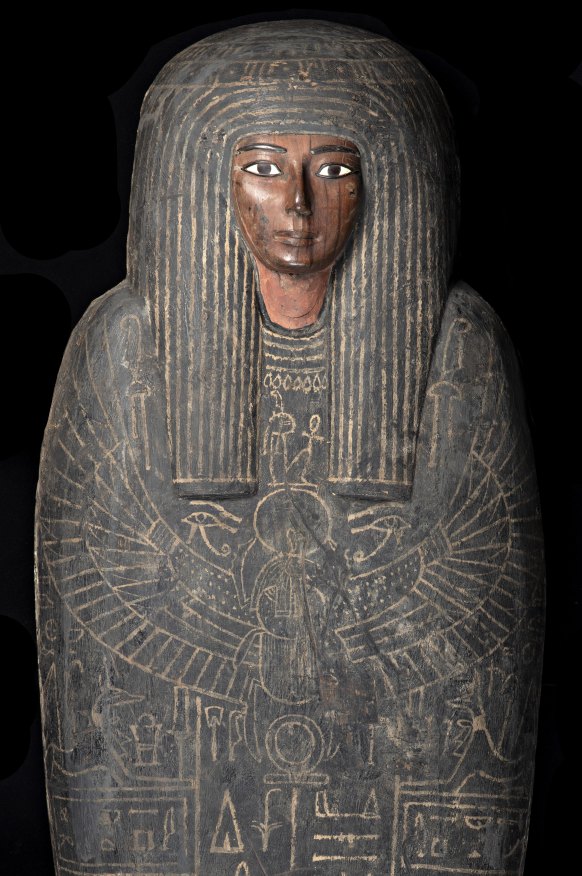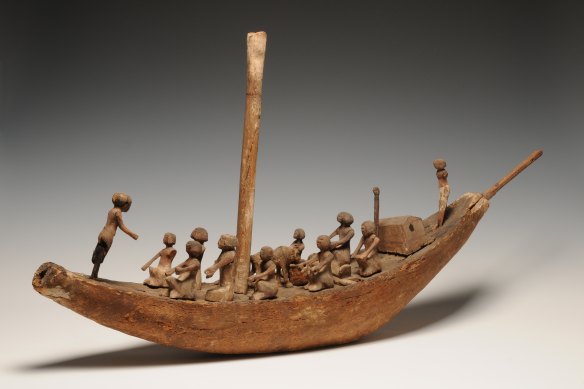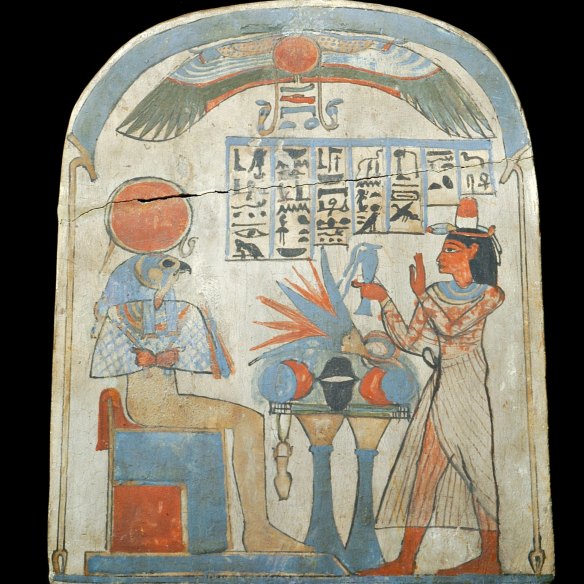
Australia has never seen a better year for “discovering ancient Egypt”, which is also the title of the show at the National Museum of Australia. We’ve had the wildly successful Ramses and the Gold of the Pharaohs at the Australian Museum; Pharaoh, on display at the National Gallery of Victoria; and this large survey from the Dutch National Museum of Antiquities, which provides another good reason for visiting Canberra, alongside the Gauguin exhibition at the National Gallery of Australia.
This may be as close as Australia has come to an outbreak of Egyptomania – a syndrome that has returned periodically throughout history, although its major onset occurred after Napoleon’s Egyptian campaign of 1798-1801. The invasion was a military failure (although Napoleon did his best to make it sound like a triumph), but it would produce the landmark series of publications known as the Description de l’Égypte (1809-29). When Jean-François Champollion deciphered the Rosetta Stone circa 1822, teaching us how to read hieroglyphics, it opened the door to a flood of new interest from scholars, artists, writers, fashion and furniture designers. Ancient Egypt was suddenly a la mode, and the hunt for souvenirs became an industry.
In the Victorian era that interest was bolstered by Amelia Edwards’s best-selling travel book, A Thousand Miles Up the Nile (1877), which stimulated a new wave of cultural tourism. The big bang, however, came with Howard Carter’s unearthing of Tutankhamun’s tomb in 1922, an event which has never lost its place in the popular imagination. Mention Egypt and most people think of Tutankhamun’s golden funerary mask, its blank-eyed stare drawing us 3000 years into the past.

Outer coffin of Panesy, 22nd Dynasty, about 943–746 BCE at the National Museum of Australia, Discovering Ancient Egypt.Credit: Rijksmuseum van Oudheden (Leiden, The Netherlands)
The Museum of Antiquities (Rijksmuseum van Oudheden aka the RMO) in Leiden, the Netherlands, opened in 1818, which is impressive. It’s even more impressive that some items in its collection were acquired in 1620, albeit partly to make “mummy powder” for dubious medical purposes. The museum has more than 25,000 objects in its permanent collection, of which 200 have been allowed to travel to Australia to be shown in Perth, Canberra and Brisbane.
Discovering Ancient Egypt doesn’t have the showmanship of Ramses, or the extraordinary design of Pharaoh, but it’s an intelligent, well-chosen exhibition that tells viewers almost everything they need to know about its subject. It’s also the only show that includes human mummies, for which audiences have a morbid fascination.
Perhaps because of their regular appearance in B-grade horror movies, the mummies attract more attention than anything else in the Egyptian departments of museums, but the current climate is making institutions nervous. In this show, the mummies are displayed in a special area, with a cautionary sign for those who might be upset or offended at the sight of human remains. There’s even a translucent “trigger warning” page in the catalogue before one reaches the relevant entry.
Am I alone in thinking this is over the top? If someone can’t bring themselves to look at a bandaged figure that died thousands of years ago, one wonders how they will cope with those experiences of death, illness and personal grief that are rites of everyday life. This kind of extreme sensitivity is making it progressively harder for archaeologists to examine burial sites, a process that helps us understand much that is relevant today.

Model boat, 11th Dynasty, about 2080–1940 BCE.Credit: Rijksmuseum van Oudheden
To take an example close to home, it’s only through the efforts of archaeologists that Indigenous people can say they’ve been here for 65,000 years, but the sacredness now invested in ancient bones means the scientists are being progressively blocked from undertaking this kind of research. It has become a huge issue to find protocols that respect Indigenous sensitivities but don’t derail efforts to learn more about people and civilisations of the past.
The day is not far off when mummies will be kept in storage and shown only to authorised parties. That will be a blow to ancient Egypt’s popularity, as they are a vital part of the story of the preparation for the afterlife that dominates every Egyptian exhibition. It’s not only the elaborate sarcophagi; it’s the tomb paintings, the sculptures and steles; the papyrus copies of the Book of the Dead; the canopic jars in which the organs of the embalmed person were preserved; the tiny shabti figures meant to provide a workforce in the afterlife, and so on. The bulk of our knowledge of the Pharaonic period has come out of tombs, as all those items intended for use in the next world have been exhumed, collected and analysed in this one.
This show has a number of spectacular, beautifully preserved sarcophagi, such as the Outer Coffin of Panesy, a priest from the 22nd Dynasty (943-746 BCE). More monochromatic than most of these coffins, Panesy’s face has been left in its natural wood. On the inside of the coffin lid, we find a large-scale depiction of the sky goddess, Nut.

Stela of Pamaaf, Third Intermediate Period, 22nd Dynasty, about 943–746 BCE.Credit: Rijksmuseum van Oudheden
The inner and outer coffins of another priest, Amenhotep (21st Dynasty, 1076-944 BCE), are more glittering affairs, covered in gold paint, hieroglyphs, small images and faience inserts. A more modest version of Nut spreads large wings across the torso of the deceased. If we discount the mummies, these ornately decorated coffins are this exhibition’s major attractions. They testify to the importance assigned to the preparation for life after death and the central role art played in ancient Egypt. The inscriptions on the sarcophagi, the tomb paintings and sculptures had religious and metaphysical significance. The Book of the Dead was a practical manual helping the deceased negotiate the journey to the next world. The amulets placed on the body were also magical charms.
Until recently, Egyptology has been overwhelmingly focused on the Pharaohs, their families and retainers, the high priests and wealthy citizens who could afford a lavish burial. There has been a gradual shift towards studying the lives of those ordinary Egyptians who were virtual slaves of a system in which the king’s word was law.
Although most of this exhibition is devoted to Egyptian funerary culture, there are also objects used in daily life – pottery, jewellery, mirrors, a headrest, a flute – which help construct a picture of a more prosaic world. We’re encouraged to see the ancient Egyptians as people like us, not inhabitants of a mythical realm that gleamed with gold, as defined by Hollywood.
Loading
There’s also a new emphasis on crediting the Egyptian workers who have provided much of the hard, patient labour required for excavating the tombs. The leading archaeologists may not bear much resemblance to Indiana Jones, but they have always been viewed as heroic figures presiding over teams of anonymous drones. A new ethic of inclusivity has invited us to recognise these digs as massive team efforts.
Despite all the museum’s best attempts to make ancient Egypt more comprehensible to the public, the romance of the Pharaohs remains intact. No culture has created such a distinctive and suggestive set of images for itself, nor penetrated more deeply into the global psyche. After all, Pharaonic Egypt lasted more than 3000 years, with customs and motifs persisting from one millennium to the next. By contrast, the modern world has been a long series of political and cultural upheavals – a battle that persists to this day. One need not admire the hieratic, authoritarian regimes of the Pharaohs to marvel at their longevity. They lived in an age of faith, but today we have more and more reasons to doubt everything.
Discovering Ancient Egypt is at the National Museum of Australia, Canberra, until September 24; Queensland Museum, Brisbane, from October 25 to May 5, 2025
The Booklist is a weekly newsletter for book lovers from books editor Jason Steger. Get it delivered every Friday.









 Add Category
Add Category